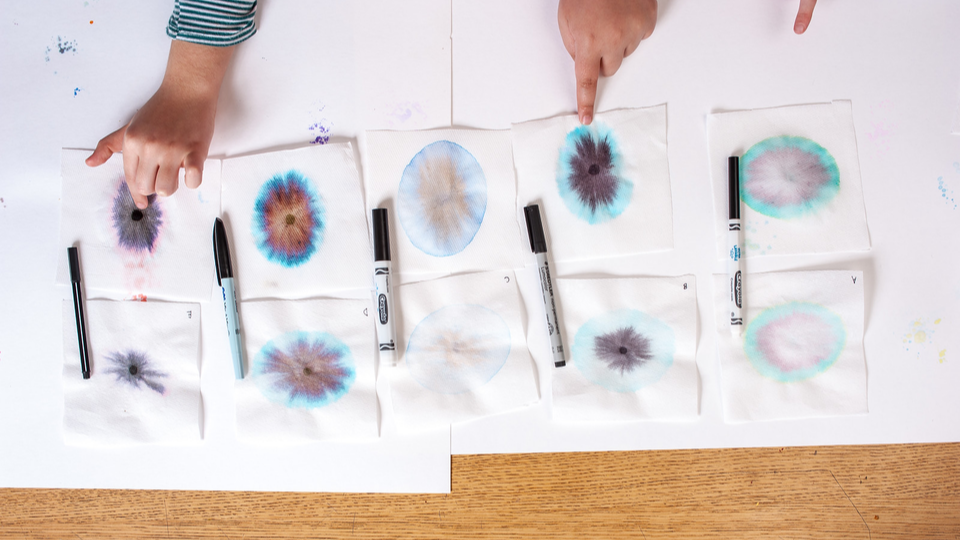
Create a colorful chromatogram at home!
“Chemistry is Colorful” encourages learners to explore materials through paper chromatography. This process highlights the properties of different pigments blended together in a marker by creating a colorful chromatogram. Can participants solve the mystery of which ink came from which marker?
This is a simplified version of Chemistry is Colorful. To get the full (and free) activity and additional resources, check out the NISE Net website.
What you will need for this activity:
Porous paper disks, 2 per participant (like filter paper, coffee filters or similar—some paper towel brands may also work)
Primary and secondary colored water-soluble markers (Vis-a-Vis or Crayola recommended)
Three different brands of black water-soluble markers (Crayola, Mr Sketch, and Vis-a-Vis all work)
An eyedropper or a vessel that lets you control drips of water
White plastic container lids (yogurt containers or similar) to hold the paper off the table
Step 1. Make a colorful pattern!
Choose two different colored markers and create a small design on a filter paper disk. It will work best if one color is a primary color (red, yellow, or blue) and one is a secondary color (purple, green, or orange. (Do not use a black marker this time!)
Place the disk onto a white lid and squeeze just a few drops of water onto the filter paper directly over your design—get your design wet with the drops.
What happens to the ink as it mixes with the water and moves on the paper? Compare the two colors you used. How are they different?

Step 2. Solve a mystery!
Set up: Have a parent or helper make a chromatogram for each of the black markers ahead of time. To do this, make an eraser-sized mark in the center of a paper disk (one for each marker), and drip a few drops of paper on the mark. The parent or helper should keep track of which marker made which chromatogram (make a small mark on the back of the disk, for example), but keep it secret! This is a mystery for later! Give these “mystery chromatograms” time to dry.
When you’re ready to do the activity, choose one of the three black markers. Make an eraser-sized circle in the center of a paper disk and fill it in. Place this disk on a plastic lid, and add a few drops of water. What happens? What colors do you see?
Compare your new filter paper pattern, or chromatogram, to the three mystery chromatograms. Which mystery chromatogram matches yours?

Step 3. Bonus: Make colorful chemistry art!
Turn your chromatograms into bookmarks or hanging decorations. Punch a hole in one edge of each disk, and tie a piece of yarn through the hole. Hang them up, and they should dry quickly.
In this activity we used a chemical process called paper chromatography. The water moves through the filter paper carrying the marker pigments and separating the different color molecules in each marker. Black markers are made by mixing many different colors. All of the different marker brands in this activity look black on the paper, but each company uses a different mix of pigments. Chromatography reveals which colors combine to make which black marker. Mystery solved!
With paper chromatography the water carries different color molecules at different speeds depending on the size of the molecule and how attracted the molecule is to the paper. For example, pigments in the secondary color orange (made from a combination of primary colors) separates out to show a range of yellows and reds.
Chemists use the process of chromatography to separate and analyze the different parts of a mixture. Different methods of chromatography use different materials (besides paper) to separate mixtures. Scientists can make chromatograms of fall leaves to show how the different leaf pigments that give plants their color break down in cooler weather. Chromatography can also be used by law enforcement in crime scene investigations, by art experts to determine original paint pigments in restoration projects, and even by food scientists. In fact, in 2013 British authorities used chromatography to discover that some meat markets were selling horse meat as ground beef!